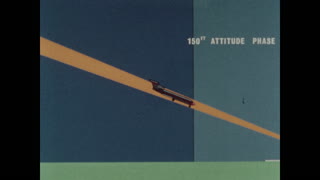This UK produced film from Smiths Aviation “The Last Hundred Feet” (1963) describes the technology behind a fully automatic landing system known as Smith’s SEP5 flight control system. It provides details on the development and implementation of SEP5, which is based on research begun in 1948. The film highlights the manufacturing precautions taken to ensure the reliability of the system, especially for civil operations requiring higher safety standards. The SEP5 system uses a multiplex principle, with duplex and triplex configurations for enhanced safety. A Vickers Varsity test aircraft is shown, but the new De Havilland Trident aircraft (introduced 1964) will also be equipped with this system, initially as a duplex and later as a triplex for regular blind landings. The film also covers the flight director and autopilot control facilities, navigation procedures, and the final approach and landing sequence, emphasizing the comprehensive safety provisions included in the SEP5 system.
00:00 – 0:34: A test Vickers Varsity aircraft is inbound for an automatic landing.
0:34 – 0:39: The aircraft is cleared to land with surface wind at 230° and 10 knots.
0:39 – 1:34: Music plays.
1:34 – 2:00: Introduction to the fully automatic landing by a research aircraft equipped with Smith’s SEP5 flight control system.
2:00 – 2:16: The development of the SEP5 system began in 1948 in collaboration with the Royal Aircraft Establishment.
Gloster Meteor and Avro Vulcan bomber. 2:16 – 2:35: The single-channel Autoland system has been used in many automatic landings.
2:35 – 2:45: The system is adopted by Britain’s RAF and fitted to V bomber squadrons.
2:45 – 3:04: Music plays.
3:04 – 3:19: The system is installed in various civil and military aircraft.
3:19 – 3:31: Smith’s Cheltenham factory produces the complex mechanisms and instruments.
3:31 – 4:00: Manufacturing precautions include ultra-clean conditions and microscopic examination of components.
4:00 – 4:12: The single-channel system provides reliability for military aircraft, but higher safety is needed for civil operations.
4:12 – 4:45: The SEP5 system, developed since 1957, uses the multiplex principle for higher safety.
4:45 – 5:01: The duplex system consists of two independent subchannels checking each other.
5:01 – 5:56: For regular automatic landing under blind conditions, three or more subchannels are required.
5:56 – 6:12: The SEP5 system in the De Havilland Trident will initially be used as a duplex system.
6:12 – 6:45: The duplex system is capable of auto-flare or auto-landing in good weather.
6:45 – 7:00: The pitch control remains automatic during landing, while lateral control is taken over by the pilot.
7:00 – 7:17: The radio altimeters take control during the flare phase.
7:17 – 7:47: The pilot takes over lateral control during the automatic flare maneuver.
7:47 – 8:03: The Trident system can be extended to triplex level for regular blind landing.
8:03 – 8:47: The Trident cockpit and equipment bay are designed for easy maintenance and modular upgrades.
8:47 – 9:12: The triplex version of the SEP5 system is installed in a research aircraft for pilot training in genuine fog operations.
9:12 – 10:00: Vickers Varsity test aircraft. The SEP5 system provides new flight director and autopilot control facilities, demonstrated in a typical flight.
10:00 – 11:01: The pilot engages the autopilot and sets the required climbing speed and heading.
11:01 – 12:02: The aircraft turns to the heading shown on the steering index and climbs to cruising altitude.
12:02 – 13:01: The system includes radio selectors for navigation and maintains the precise track.
13:01 – 14:03: The pilot selects the rate of descent and sets the height lock selectors.
14:03 – 15:29: The flight control system is coupled to the ILS beam for automatic landing.
15:29 – 16:47: The aircraft intercepts the localizer and glides down the path.
16:47 – 17:03: The pilot checks the height and sets the initial speed for the approach.
17:03 – 18:22: The radio altimeter controls the flare phase, and the rudder cancels out crosswind effects.
18:22 – 19:36: Comprehensive safety provisions are included in the SEP5 system.
19:36 – 20:03: The Trident enters service as a sophisticated and safe civil aircraft, paving the way for all-weather operations and automatic landings.
This film is part of the Periscope Film LLC archive, one of the largest historic military, transportation, and aviation stock footage collections in the USA. Entirely film backed, this material is available for licensing in 24p HD, 2k and 4k. For more information visit http://www.PeriscopeFilm.com


